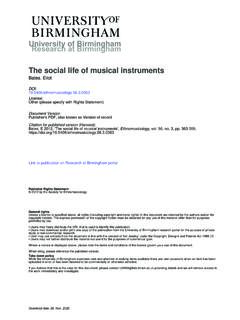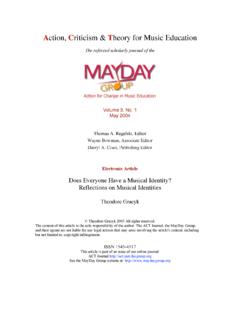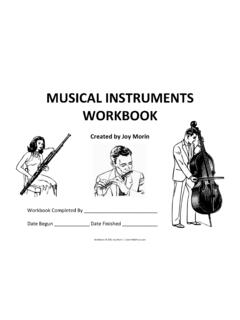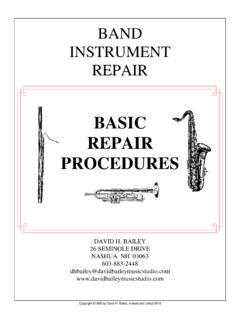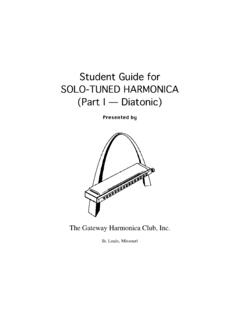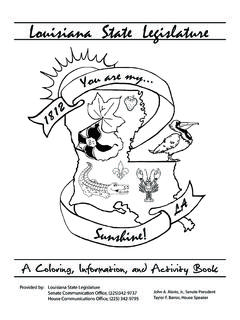Transcription of The Family of the Mbira THE EVIDENCE OF THE TUNING PLANS
1 The African e-Journals Project has digitized full text of articles of eleven social science and humanities journals. This item is from the digital archive maintained by Michigan State University Library. Find more at: Available through a partnership with Scroll down to read the article. The Family of the MbiraTHE EVIDENCE OF THE TUNING PLANSA. TraceyInternational Library of African Music, RoodeportINTRODUCTIONA bout twelve major types of Mbira areplayed at the present day by the peoples ofthe central and lower Zambezi valley and en-virons. I would like to present some evidenceto show that, in this large part of Africa atleast, all these types are related, and furtherthat several lines of descent can be postulatedwhich point back to one common area in question (see map) comprisesmost of Rhodesia, central Mozambique, south-ern and eastern Zambia, together with parts ofsouthern Malawi, southern Mocambique andnorthern Transvaal, or to put it more simply,much of the lower Zambezi basin, with a spillover towards the mbiras found in this area exhibit agreat variety in appearance, manner of con-struction, tone quality and musical maps could be drawn for eachof these factors which would not reveal an over-all relationship.
2 However, if one focuses onone factor alone, namely the arrangement ofthe notes on the keyboard, or ' TUNING plan', con-sistent relationships can be established, whichalso concord with African nomenclature. Afri-can musicians are completely decided on thenames of the various types of mbiras. What issignificant to them in this respect is not prim-arily the number of reeds, or keys, on the instru-ment, the method of sound production or anyother constructional feature, but the tuningplan. Most Mbira TUNING PLANS are more or lessirregular, in the sense that the notes of thescale are not necessarily positioned next toeach other, as they would be, for instance, ona piano or on most African xylophones. It isby tracing several significant 'irregular' tuningplans that we have been able to come tothese in TUNING PLANS can be com-pared to non-functional components of materialobjects, such as decoration, which may betransmitted unchanged from one culture toanother, the original function or symbolismbecoming lost in the process.
3 TUNING PLANS aregenerated by musical concepts or needs. Never-theless, one generally finds that an Mbira tuningplan is adopted lock, stock and barrel, whetheror not its special characteristics fill the sameneed as in the music of the originating of the irregularities that we shall befollowing then become merely a vestigialhistorical trace that links a type of Mbira withits antecedent, but does not necessarily haveany significance in the music of the peopleusing should add that I have been considerablyassisted in my research by the ability to playmost of the Mbira types under discussion, andthus to form an idea of what is actually of1musical or motor-pattern significance, and whatseems 'irregular' and should therefore beattributed to other sources, historical, socialor personal.
4 Secondly, I am not concerned withestablishing a time scale, but rather a seriesof relationships among the mbiras of this considering these relationships it becomesobvious that their development could onlyhave occurred in one direction, from simple tomore complex. One does not need to assumethis to start with, although it is also, of course,a perfectly sound ethnographic principle. It hasbeen seriously suggested to me by an ethno-musicologist, that the development took placein the other direction. On the basis of thisevidence this seems to me impossible; however,we are trying to retrieve a historical processfrom the EVIDENCE of present-day artifacts,which is always a risky what I have observed ofpresent-day African musicians is a generaltendency among leading musicians and instru-ment makers to add notes and increase the sizeof their mbiras.
5 Many inventive variants ofthe basic TUNING PLANS are produced in this way,a process similar to that which must have ledup to the currently existing Mbira in the matter of the so-called'Africanisation' of foreign musical traits, Ihave noticed that many musicians, on beingexposed to a new foreign musical instrument,whether from another part of Africa, or West-ern, will immediately play it, applying motor,rhythmic or melodic patterns to it which theyalready know. They are keen to accept innova-tions in musical instruments , providing they arecapable of expressing their own musical langu-age. In common with musicians the world over,they are rarely interested in learning theoriginal, foreign musical idiom of the instru-ment.
6 This is why the kalimba, for instance,from the north side of the Zambezi, and thekarimba, from the south side (roughly speak-ing), which are identical except in matter ofsize, can sound so completely different. Similar-ly, in organological terms, when a new typeof Mbira is adopted, the significant adoption isthe TUNING plan; other details of constructionwill usually continue to be based on those ofthe local Mbira type, such as the shape andsize of body, profile of the reeds, attachmentof bridge, bar and backrest, method of effect-ing buzz-tone, and choice of resonating 1 presents in simplified form thefamily relationships of the mbiras under dis-cussion; their geographical distribution andsupplementary description is shown in themap and its subtitles.
7 Diagrams 2-4 present ingraphic form the actual TUNING PLANS on whichthis study is based. For present purposes wedo not need to follow the steps in detail; readerswho are interested may find it more fully des-cribed in Tracey (1972). Here it will be suffi-cient to point out the main points of similarityamong the members of the three lines orfamilies of Family OF THE KALIMBAThe present-day kalimba is played over awide area, mostly north of the there are added notes, bent up to forman upper rank, or manual, in the manner ofthe Nsenga kalimba illustrated. On the southbank the kalimbalkarimba name is retained,but the instrument is considerably enlarged,giving a foretaste of the further enlargementsand transformations other south-bank mbirashave undergone.
8 The original kalimba 'core' TUNING plan is shown in black, to show how itremains embodied in the subsequent tuningplans of this Family . The njari, already an in-dependent instrument from the kalimba, makesits additions in its own way, the most significantbeing the enlargement of the bass section forthe left thumb. The njari huru, or 'big njari',is just that the bass section is further en-larged, and the right hand rank is extended byfive more dipila is included here tentatively, as Ido not have conclusive EVIDENCE for its mem-bership in the kalimba Family . However,allowing for the fact that it is pentatonic, itstuning plan is strikingly similar to that of thekalimba. The black notes here represent thebasic form of the instrument, as acknowledgedby dipila players; the white notes are note on the numbering system used the numbers 1 to 7 indicate the seven notes ofthe heptatonic scales used on most of thembiras in our area; 1 to 6, respectively, if thescale is hexatonic (for instance the Mbira dzavaNdau, Diagram 4), and 1 to 5 for the onlypentatonic instrument in the area, the is, the heavy black lines are an octaveapart, divided respectively into 5, 6 or 7 inter-* * > %A i-i ivals.
9 This numbering system does not showtonal, intonational or musical importance ofnotes, but it is carried through all the diagramsto facilitate comparison between the differenttuning Family OF Mbira DZAVADZIMUThe Mbira dzavadzimu and mbila deza,probably the older members of this Family ,embody the kalimba core in the centre of theirkeyboard, completely intact but for the factthat it is left-right reversed. Again the blacknotes show the kalimba core. The major addi-tion in these two instruments is the new lowsection for the left hand, in octaves below the7-6-5-1 of the kalimba core. The note no. 4,whose irregular position was one of the sparksfor this investigation, has been inserted herein yet a different position than the two positionsfound in the karimba-njari Family already dis-cussed.
10 Note that in the original kalimba thenote 4 does not exist, so musicians in a hepta-tonic tradition, faced with a hexatonic instru-ment, had to find a new place for the extranote. In the hexatonic Ndau Mbira , of course,this note has never been the Mbira dzavadzimu TUNING plannow as our model, with its characteristicirregularity in the left hand, we can see thatthe hera and nyonganyonga both embody it asthe basis of their own enlarged keyboards, theonly difference being the shifting of note 3away from its original isolated position. Thetransposition two octaves down of the righthand rank 1, 2, 3, etc in the nyonganyongacan probably be accounted for by the charac-teristic method of TUNING these last two mbiras,the hera and nyonganyonga: the overtones ofthe deep notes, rather than the fundamentals,are taken as the significant TUNING notes.

